BY LETTER
Burning Library Project, The
History > 0030 to 0900 AT: Solsys Era > 030 to 130 AT: The Information Age
Science > Biology
Technology > Technology Type or Material > Gengineering
Science > Paleontology
History > Significant Historical Events
Science > Biology
Technology > Technology Type or Material > Gengineering
Science > Paleontology
History > Significant Historical Events
 Image from Anders Sandberg |
From the late Industrial Age through the Information Age, huge numbers of species were driven to extinction on Old Earth as a result of human activity. Many of these have apparently been lost forever, despite the efforts of GAIA to restore the planet's original flora and fauna in the millennia since. This episode is sometimes known as the Great Dying. Even more life forms might have been lost forever if not for the Burning Library Project.
The concept of the Burning Library Project arose in the first century a.t. once the phenomenon of the Great Dying became evident. The name of the project was metaphorical. Imagine, said proponents, that you are a scholar in one of the great libraries of the Agricultural Age, such as that at Alexandria. A fire breaks out. You cannot stop the fire, and you cannot save all of the scrolls. There is little time to think or to evaluate the situation. What to do? You scoop up as many scrolls as you can on your route to the nearest exit, if time permits choosing those that appear to be more important or unique. The result is not ideal, but it is preferable to letting the entire collection go up in flames. Some well-known biologists of the day proposed such efforts. Better, they said, to record indiscriminately than to lose the entire collection. However, for a variety of reasons there never was a single centrally organized Burning Library Project. Rather, individual librarians (individuals, some corporations, some government agencies and some non-governmental organizations) each did the best they could, from a variety of motives, and the efforts were very loosely coordinated over the primitive Net of the day. The Burning Library Project's most active phase lasted from about 68 a.t. to 112 a.t. Data on hundreds of thousands of species was saved; everything from cell samples to genetic sequences to studies of behaviour and ecology. Some people also made attempts to record and preserve data on human languages and cultures, and specific local human genotypes which were also undergoing a major extinction event during this period. Such projects were initially considered a separate venture by those preoccupied with recording other species, but eventually fell under the same label.
Much of the information recorded for the project was damaged or lost during the Technocalypse. However, at some time in the chaos of the early Technocalypse years some unknown individual or individuals collected significant fractions of this information into archives and launched them into interplanetary space, each with a guardian artificial intelligence. Even the AIs of these caches do not know who this anonymous benefactor of Terragen civilization may have been. The discovery of even a single such cache was the foundation of tremendous personal wealth and success in the post-Technocalypse era. Perhaps one of the most famous instances is that of the founders of the Institute For Primate Provolution, who found a nearly intact cache containing data on nearly every primate species known to Old Earth from the advent of humanity onwards.
Attempts to reconstitute the entire contents of Burning Library Project have been ongoing since the early days of the First Federation, and organizations such as the Jurassica Institute are still actively searching for new data even today. Solsys has been quite thoroughly combed for caches or other remains of the project, though some archaeologists still dream of finding something new in some wrecked and nanite-infested hab somewhere in orbit around Sol or one of its satellites. More realistic individuals have looked for artefacts or records in the systems and on the planets colonized prior to the Technocalypse. Some have suggested that interstellar space be combed for transmissions that might have been beamed outwards during the pre-Technocalypse era, but at this late date such signals have long ago left the Terragen sphere.
Some believe that GAIA recovered all or most of the original project's biological data early in her existence but has concealed its contents and location from the rest of Terragen civilization. Rumours concerning this, and her possible motivations for doing so, are too numerous to mention. As in so many other instances, she and her agents have refused even to discuss the matter.
Related Articles
Appears in Topics
Development Notes
Text by Stephen Inniss
Initially published on 10 September 2005.
Initially published on 10 September 2005.






